
MetaGPT
Introduction
A groundbreaking innovation in the field of Artificial Intelligence (AI) is making waves – MetaGPT. This state-of-the-art platform possesses the unique ability to develop websites, applications, and various digital products utilizing only natural language prompts.
As a top-tier tech fan, I have delved into this platform and eagerly present to you its functionality, capabilities, and prospective influence on the technology industry.
MetaGPT: Build Full Apps and Websites with Zero Code
Discovering MetaGPT
MetaGPT is an AI platform driven by GPT-4, currently in development by OpenAI. GPT-4 serves as the fourth instalment of OpenAI’s language model, proficient in comprehending natural language text and generating high-quality responses. Built upon this cutting-edge technology, this platform can establish websites, apps, and other digital products using natural language prompts as a basis.
MetaGPT Operating Process
MetaGPT functions by interpreting natural language prompts input by users, subsequently generating code founded on these instructions. The platform can produce code in an array of programming languages such as HTML, CSS, and JavaScript. Upon generating the code, users may modify and edit it to suit their explicit requirements.
Additionally, this platform can be employed to develop chatbots, voice assistants, and a variety of AI-driven applications. These apps can be designed to understand natural language while responding to user inquiries effectively, thus proving invaluable for customer service and support initiatives.
Exploring MetaGPT’s Capabilities
The vast capabilities of MetaGPT hold tremendous potential to redefine how we craft digital products. Some remarkable features of it are:
- Swift Prototyping: Utilizing MetaGPT enables rapid prototyping for websites, apps, and diverse digital products. This allows developers to assess concepts and refine designs expediently.
- Tailorable Templates: A collection of adaptable templates is readily available within MetaGPT, simplifying the process of establishing websites, apps, or other digital products.
- AI-Driven Applications: MetaGPT facilitates the creation of chatbots, voice assistants, and numerous AI-powered applications capable of natural language comprehension and user query responses.
- Multilingual Compatibility: Besides generating code in multiple programming languages (HTML, CSS, JavaScript), MetaGPT is designed to support various languages for an enhanced user experience.
How to Use MetaGPT
The MetaGPT platform is a powerful and innovative tool for developing websites and applications quickly.
Time Needed : 00 hours 05 minutes
In this tutorial, we’ll guide you through the process of using MetaGPT to develop your own app or website, in less than 5 minutes, no coding experience is needed. Let’s get started!
Step 1: Access MetaGPT
 To start using MetaGPT, visit the official website at picoapps.xyz/metagpt. Once you are there, click on the “Get started for free” button.
To start using MetaGPT, visit the official website at picoapps.xyz/metagpt. Once you are there, click on the “Get started for free” button.Step 2: Sign Up
 Fill out the registration form and follow the instructions to sign up. Signing up is free, however, take note that you will have just 3 app generation trials to test the platform before being forced to upgrade to a paid plan for further usage, so, use your trials wisely.
Fill out the registration form and follow the instructions to sign up. Signing up is free, however, take note that you will have just 3 app generation trials to test the platform before being forced to upgrade to a paid plan for further usage, so, use your trials wisely.Step 3: Log In
 Once you are done signing up, you can go ahead and log in. Once you have logged in, you will be presented with an interface, as shown in the image above.
Once you are done signing up, you can go ahead and log in. Once you have logged in, you will be presented with an interface, as shown in the image above.Step 4: Get Inspiration
 You can scroll down the page and check out sample projects people have done, using the platform, such as a Daily planner app and a Radio app. This is illustrated in the image above.
You can scroll down the page and check out sample projects people have done, using the platform, such as a Daily planner app and a Radio app. This is illustrated in the image above.Step 5: Enter Prompt
 Now, you can either choose between the “Pico Builder” and the “MetaGPT Builder” for your app. The “Pico Builder” is the platform’s inbuilt app builder, which may generate your responses quicker. The “MetaGPT Builder” uses OpenAI’s GPT-4 to process requests, and is slower to build, but produces better results.Once you have chosen what builder you want to use, write your prompt in the text box, as seen in the image above. Try to be as descriptive and explanatory as possible, as it helps improve the overall result. If you are out of ideas, you can get inspiration by looking at the “Ideas” section below the text input box.Also, make sure to read the guidelines for creating apps in the last section below. Once you are done inputting your prompt, you can click on the “Create” button.
Now, you can either choose between the “Pico Builder” and the “MetaGPT Builder” for your app. The “Pico Builder” is the platform’s inbuilt app builder, which may generate your responses quicker. The “MetaGPT Builder” uses OpenAI’s GPT-4 to process requests, and is slower to build, but produces better results.Once you have chosen what builder you want to use, write your prompt in the text box, as seen in the image above. Try to be as descriptive and explanatory as possible, as it helps improve the overall result. If you are out of ideas, you can get inspiration by looking at the “Ideas” section below the text input box.Also, make sure to read the guidelines for creating apps in the last section below. Once you are done inputting your prompt, you can click on the “Create” button.Step 6: Add Details
 In this section, first enter the various inputs the app will require from the user. Now, suggest the prompt that the app will use, once the user starts using the app. Finally suggest what form the output from the app should look like. you can choose between text, tabular or even graphical (chart) output.Next, choose the theme of your app. You can choose any of the predefined themes, such as “Retro“, “Dark“, “Rainbow” and “Apple“. At the last input of the page, you can link your app to your website. Just add your website’s URL there.Once you are done with this section, you can click on the “Create” button, to launch the creation of your app or website.
In this section, first enter the various inputs the app will require from the user. Now, suggest the prompt that the app will use, once the user starts using the app. Finally suggest what form the output from the app should look like. you can choose between text, tabular or even graphical (chart) output.Next, choose the theme of your app. You can choose any of the predefined themes, such as “Retro“, “Dark“, “Rainbow” and “Apple“. At the last input of the page, you can link your app to your website. Just add your website’s URL there.Once you are done with this section, you can click on the “Create” button, to launch the creation of your app or website.Step 7: Build App
 After clicking on the “Create” button, you have to be a little patient, while the AI processes your prompt.
After clicking on the “Create” button, you have to be a little patient, while the AI processes your prompt.Step 8: Preview App
 After MetaGPT has finished building your app, it will give you a preview of what it looks like. From the image above, you can already see one fatal flaw. There seems to be an unnecessary ” ”’html ” text at the top of the page.
After MetaGPT has finished building your app, it will give you a preview of what it looks like. From the image above, you can already see one fatal flaw. There seems to be an unnecessary ” ”’html ” text at the top of the page.Step 9: Choose Modification
 The mistake is probably from the AI build. To fix it, we can either proceed to use the “ITERATE” option, where we modify our app using just text input, or we can proceed to modify the app using code.
The mistake is probably from the AI build. To fix it, we can either proceed to use the “ITERATE” option, where we modify our app using just text input, or we can proceed to modify the app using code.Step 10: Iterate App
 If you are choosing to modify your app using the iterations method, just click on the “ITERATE” button, which will take you to the top of the page. At the top of the page, you will see the text input section, which permits you to input prompts for modifying your current app. Enter what you want to be modified, and click the “UPDATE” button.
If you are choosing to modify your app using the iterations method, just click on the “ITERATE” button, which will take you to the top of the page. At the top of the page, you will see the text input section, which permits you to input prompts for modifying your current app. Enter what you want to be modified, and click the “UPDATE” button.Step 11: View Code
 If you are a developer instead, the second method of modifying, consisting of directly editing the code, might cam in handy. To edit code, Click the “EDIT CODE DIRECTLY” option. As seen in the image above, the code is rendered in the above code editor. This permits us to quickly fix the ” ”’html ” appearing at the top of the page, by deleting it.
If you are a developer instead, the second method of modifying, consisting of directly editing the code, might cam in handy. To edit code, Click the “EDIT CODE DIRECTLY” option. As seen in the image above, the code is rendered in the above code editor. This permits us to quickly fix the ” ”’html ” appearing at the top of the page, by deleting it.Step 12: Verify Code
 After modifying the code, verify if everything is fine and save your work. As you can see, the ” ”’html ” line has been removed.
After modifying the code, verify if everything is fine and save your work. As you can see, the ” ”’html ” line has been removed.Step 13: Preview Modification
 After completing your modifications, you can preview your app to make sure everything is stable.
After completing your modifications, you can preview your app to make sure everything is stable.Step 14: Test and Deploy
 Below the input text bar at the top, you will find a generated link to the hosted version of your project. You can use the link to access the live version of your project or share it with others.
Below the input text bar at the top, you will find a generated link to the hosted version of your project. You can use the link to access the live version of your project or share it with others.
Consequential Effects of MetaGPT
The influence of MetaGPT on the tech scene is noteworthy. The platform aims to level the playing field in terms of website and app creation, opening doors for individuals from all walks of life. This development could result in a surge of diverse digital products and services, eventually transforming the tech landscape.
Furthermore, this platform can facilitate the production of AI-driven applications that are finely tuned to address users’ requirements and adept at tackling intricate issues. This may give rise to groundbreaking innovations in fields such as healthcare, finance, and transportation.
Conclusion
To sum up, MetaGPT is an impressive new platform with the promise to reshape how we approach the creation of digital products. Harnessing the prowess of GPT-4, this platform generates code in response to natural language prompts, expediting and simplifying processes related to websites, apps, and other digital products.
Now, do I recommend it? Well, sort of.
If you want to build a simple app, you can use it to do some quick development. Nevertheless, the more complicated your app requirements are, the less capable and accurate this platform becomes at building your app.
Some Frequently Asked Questions and Their Answers
What is MetaGPT?
MetaGPT is an AI platform driven by GPT-4, it can establish websites, apps, and other digital products using natural language prompts as a basis.
Is MetaGPT available for public use?
Yes, MetaGPT is available for public use and can be accessed from any country in the world.
Is MetaGPT Free?
MetaGPT is not completely free. You can sign up for free, but when you do, you will get a trial version which will come with 3 trial usage. Once your trials are exhausted, you will have to upgrade to a paid plan to continue using.
How can I start using MetaGPT?
Just sign up at the MetaGPT website using the following link: picoapps.xyz/metagpt.
Is there a waiting list for MetaGPT?
No, there’s no waiting list, all you have to do is just to sign up and start using it immediately.
How is MetaGPT different from ChatGPT?
MetaGPT is primarily meant for building apps and websites, while ChatGPT is meant to answer questions asked by users.
What are the benefits of using MetaGPT?
MetaGPT can be used to build apps and websites quickly, with no programming experience, just by giving prompts in natural language.
How can MetaGPT be used in real-world applications
MetaGPT can be used for building AI-powered applications, such as AI-powered chatbots which can be used to naturally understand and answer people. A bot like this could be used in customer service.
References
- marktechpost.com: Meet MetaGPT: A GPT-4-powered Application That Can Create Websites, Apps, And More Based Only On Natural Language Prompts – MarkTechPost.
- analyticsindiamag.com: MetaGPT — Realising the GPT-4 Dream.
Other Interesting Articles
- Use ChatGPT 4 for Free Without a Plus Subscription: Learn how to use ChatGPT 4 for free without a Plus subscription. Use this guide and start generating high-quality responses today…
- OpenAI ChatGPT Course: Developer AI Course: Discover the power of OpenAI ChatGPT Course technology with our comprehensive course. Learn language modelling, chatbots… Enrol now!
- GPT-5 AGI PATH: An Introduction to AGI: Discover the power of GPT-5 and how it could pave the “GPT-5 AGI path” towards achieving Artificial General Intelligence…









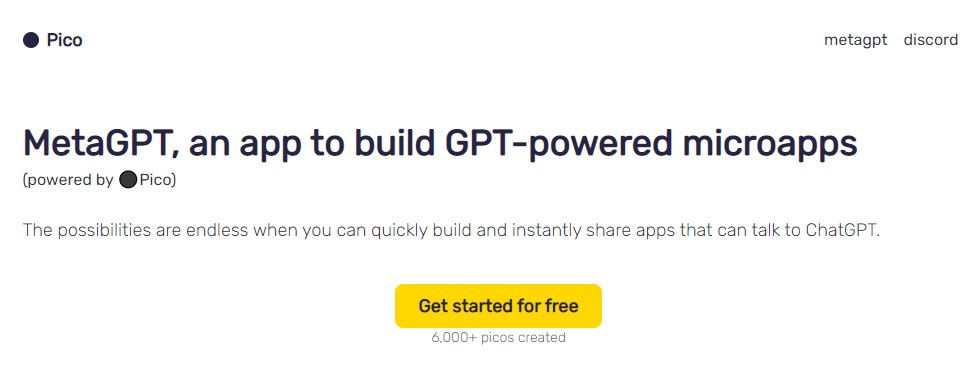 To start using MetaGPT, visit the official website at
To start using MetaGPT, visit the official website at 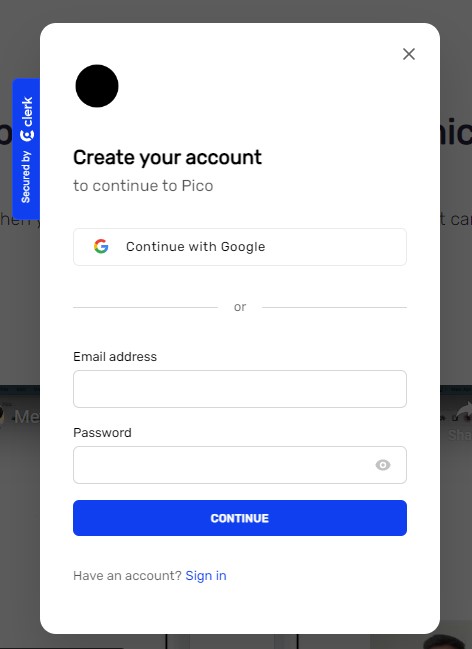 Fill out the registration form and follow the instructions to sign up. Signing up is free, however, take note that you will have just 3 app generation trials to test the platform before being forced to upgrade to a paid plan for further usage, so, use your trials wisely.
Fill out the registration form and follow the instructions to sign up. Signing up is free, however, take note that you will have just 3 app generation trials to test the platform before being forced to upgrade to a paid plan for further usage, so, use your trials wisely.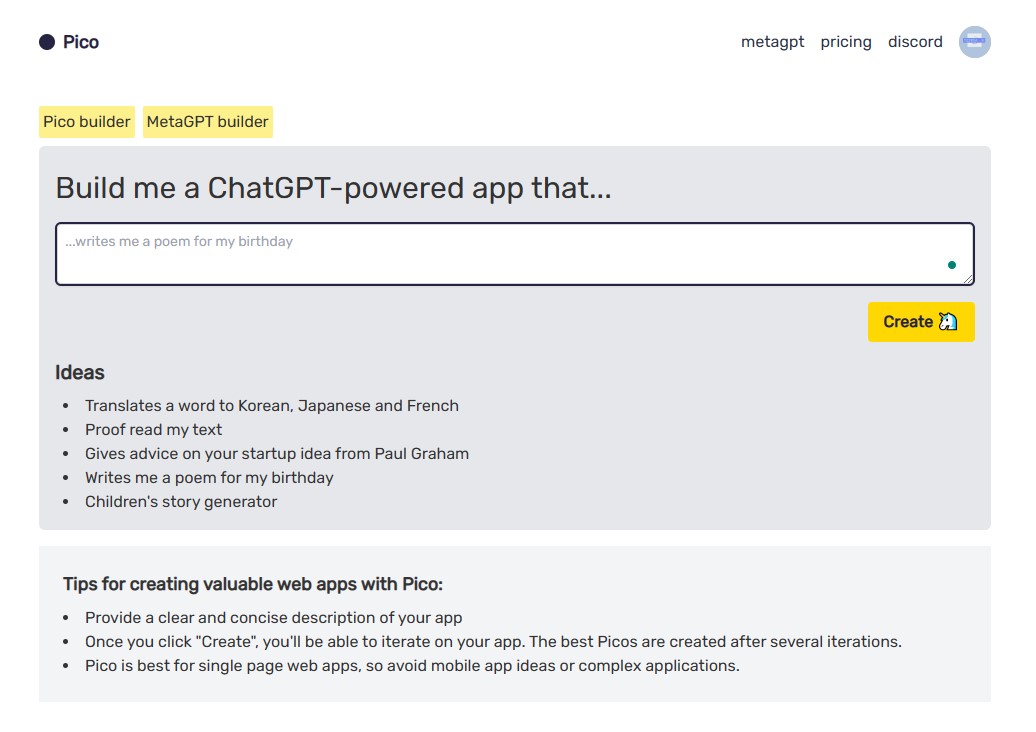 Once you are done signing up, you can go ahead and log in. Once you have logged in, you will be presented with an interface, as shown in the image above.
Once you are done signing up, you can go ahead and log in. Once you have logged in, you will be presented with an interface, as shown in the image above.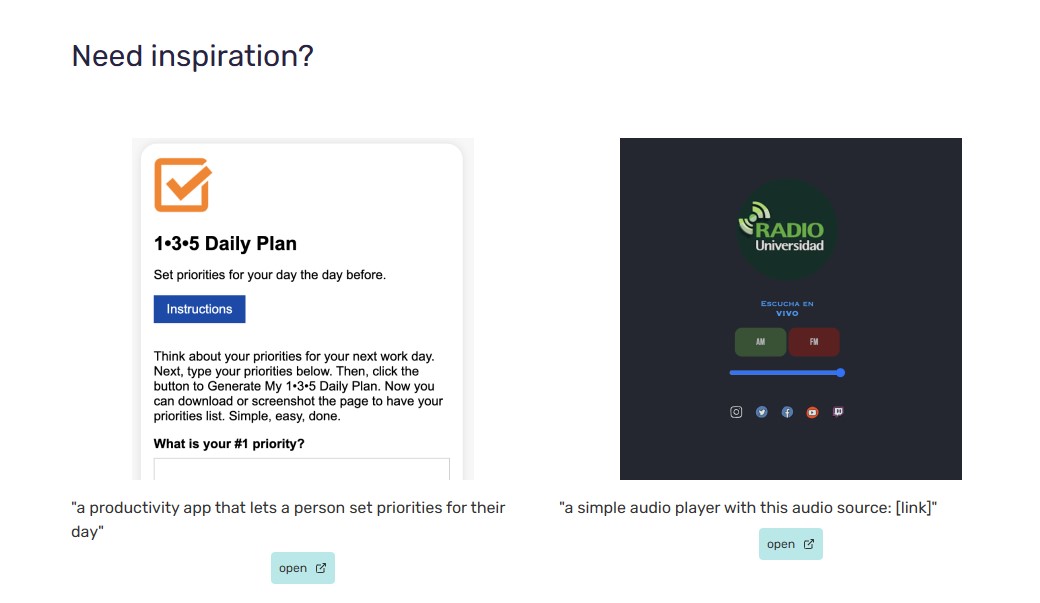 You can scroll down the page and check out sample projects people have done, using the platform, such as a Daily planner app and a Radio app. This is illustrated in the image above.
You can scroll down the page and check out sample projects people have done, using the platform, such as a Daily planner app and a Radio app. This is illustrated in the image above.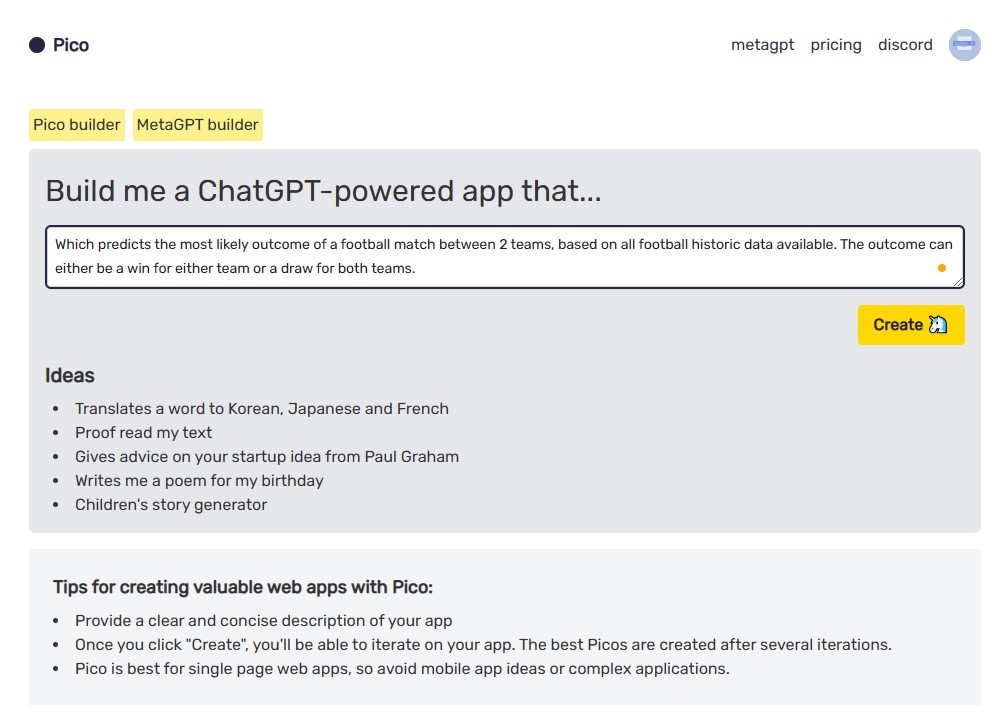 Now, you can either choose between the “Pico Builder” and the “MetaGPT Builder” for your app. The “Pico Builder” is the platform’s inbuilt app builder, which may generate your responses quicker. The “MetaGPT Builder” uses OpenAI’s GPT-4 to process requests, and is slower to build, but produces better results.Once you have chosen what builder you want to use, write your prompt in the text box, as seen in the image above. Try to be as descriptive and explanatory as possible, as it helps improve the overall result. If you are out of ideas, you can get inspiration by looking at the “Ideas” section below the text input box.Also, make sure to read the guidelines for creating apps in the last section below. Once you are done inputting your prompt, you can click on the “Create” button.
Now, you can either choose between the “Pico Builder” and the “MetaGPT Builder” for your app. The “Pico Builder” is the platform’s inbuilt app builder, which may generate your responses quicker. The “MetaGPT Builder” uses OpenAI’s GPT-4 to process requests, and is slower to build, but produces better results.Once you have chosen what builder you want to use, write your prompt in the text box, as seen in the image above. Try to be as descriptive and explanatory as possible, as it helps improve the overall result. If you are out of ideas, you can get inspiration by looking at the “Ideas” section below the text input box.Also, make sure to read the guidelines for creating apps in the last section below. Once you are done inputting your prompt, you can click on the “Create” button.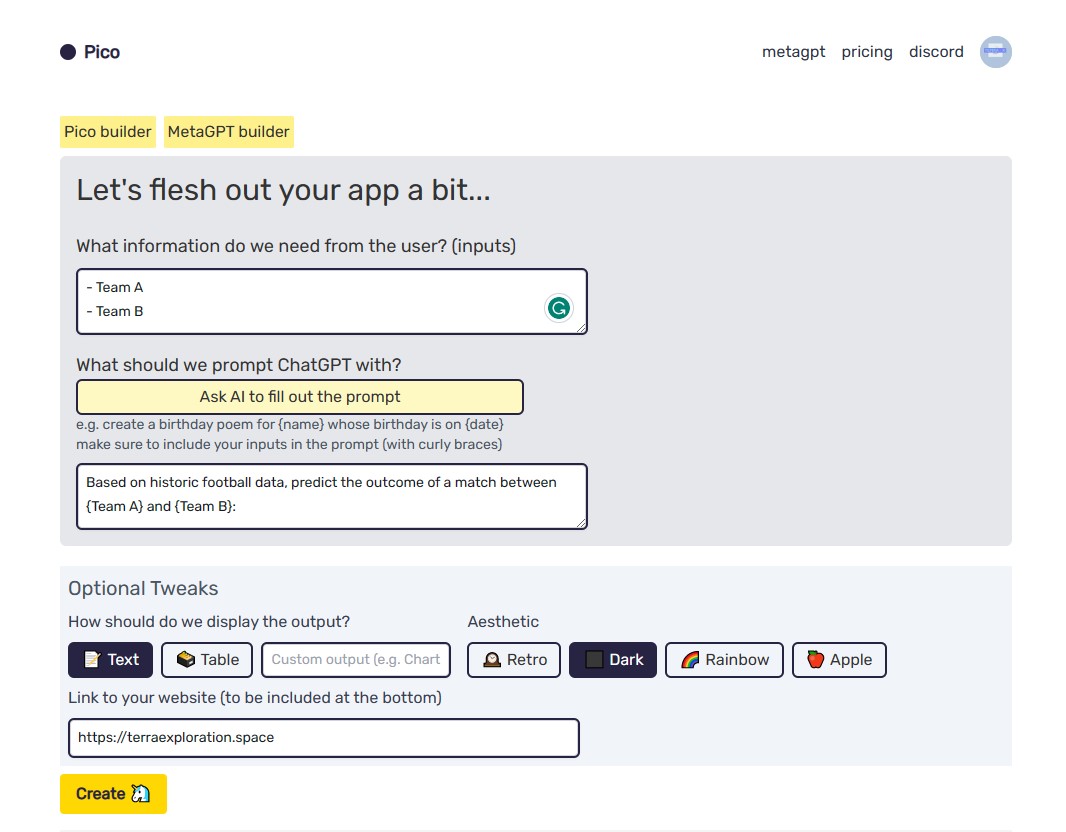 In this section, first enter the various inputs the app will require from the user. Now, suggest the prompt that the app will use, once the user starts using the app. Finally suggest what form the output from the app should look like. you can choose between text, tabular or even graphical (chart) output.Next, choose the theme of your app. You can choose any of the predefined themes, such as “Retro“, “Dark“, “Rainbow” and “Apple“. At the last input of the page, you can link your app to your website. Just add your website’s URL there.Once you are done with this section, you can click on the “Create” button, to launch the creation of your app or website.
In this section, first enter the various inputs the app will require from the user. Now, suggest the prompt that the app will use, once the user starts using the app. Finally suggest what form the output from the app should look like. you can choose between text, tabular or even graphical (chart) output.Next, choose the theme of your app. You can choose any of the predefined themes, such as “Retro“, “Dark“, “Rainbow” and “Apple“. At the last input of the page, you can link your app to your website. Just add your website’s URL there.Once you are done with this section, you can click on the “Create” button, to launch the creation of your app or website.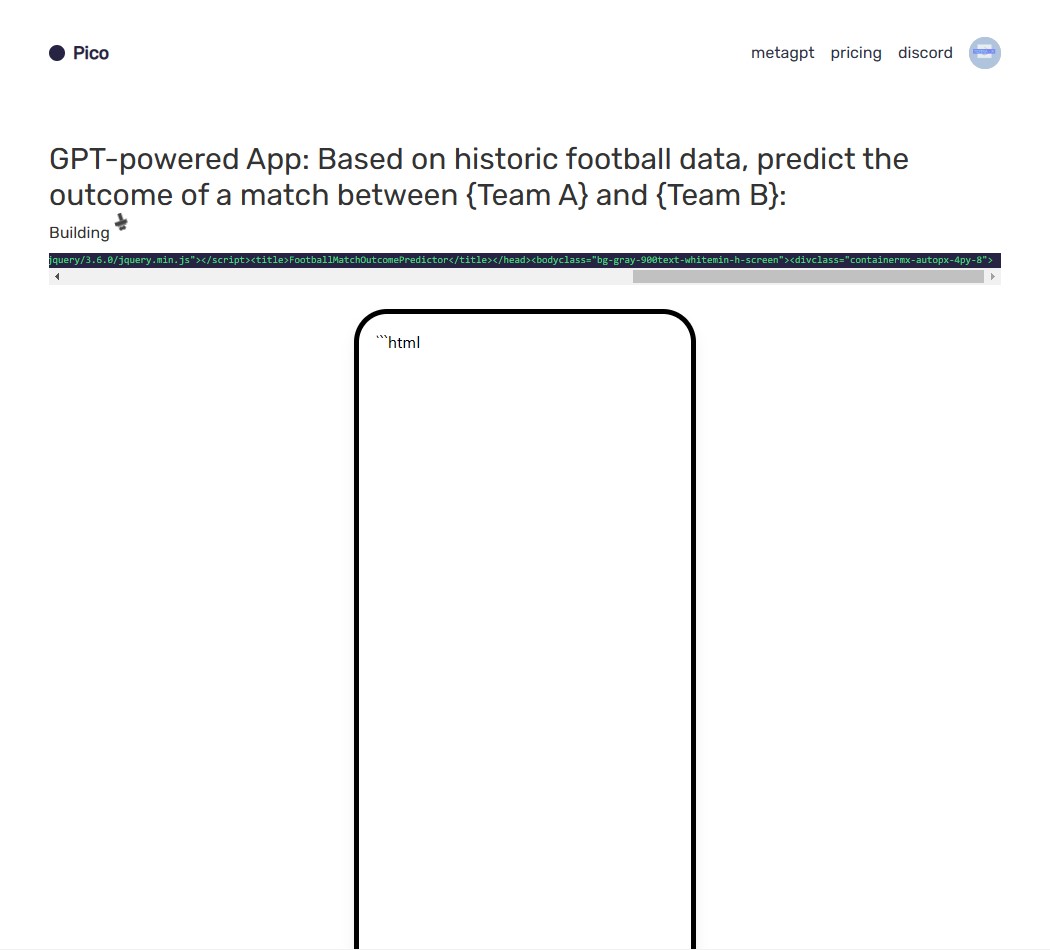 After clicking on the “Create” button, you have to be a little patient, while the AI processes your prompt.
After clicking on the “Create” button, you have to be a little patient, while the AI processes your prompt.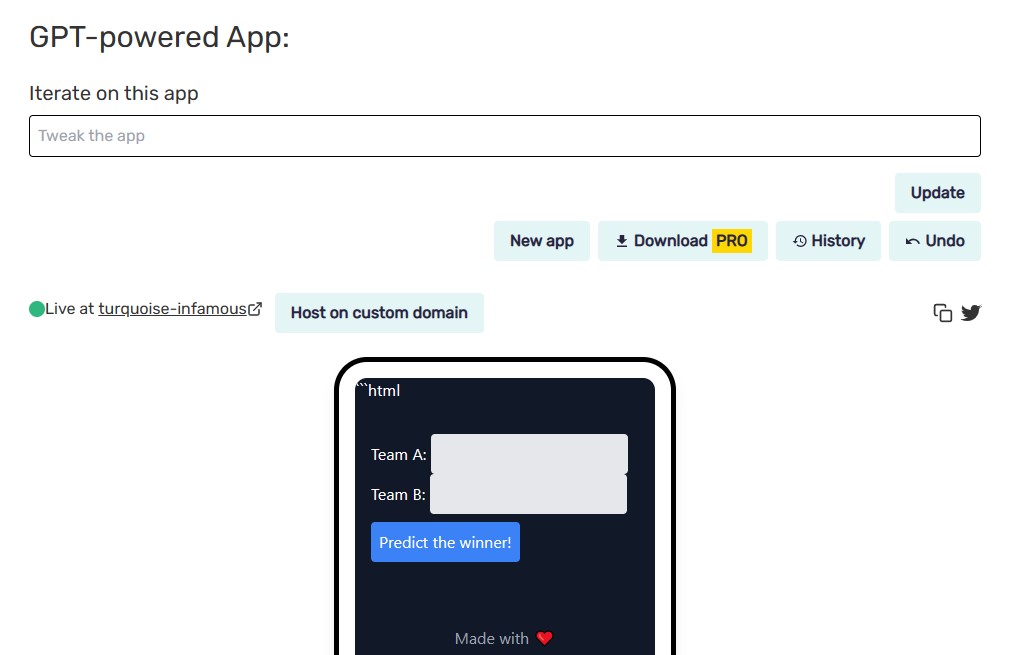 After MetaGPT has finished building your app, it will give you a preview of what it looks like. From the image above, you can already see one fatal flaw. There seems to be an unnecessary ” ”’html ” text at the top of the page.
After MetaGPT has finished building your app, it will give you a preview of what it looks like. From the image above, you can already see one fatal flaw. There seems to be an unnecessary ” ”’html ” text at the top of the page.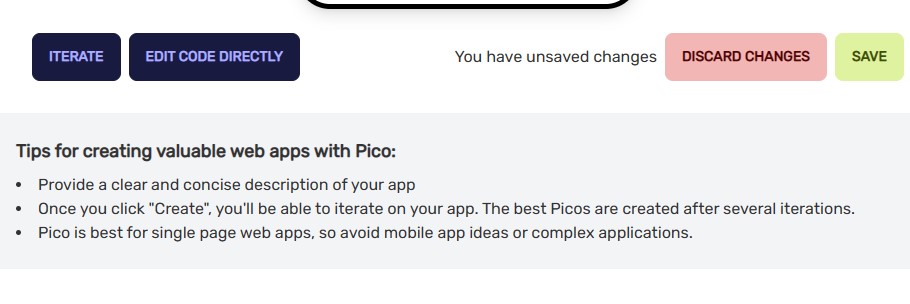 The mistake is probably from the AI build. To fix it, we can either proceed to use the “ITERATE” option, where we modify our app using just text input, or we can proceed to modify the app using code.
The mistake is probably from the AI build. To fix it, we can either proceed to use the “ITERATE” option, where we modify our app using just text input, or we can proceed to modify the app using code. If you are choosing to modify your app using the iterations method, just click on the “ITERATE” button, which will take you to the top of the page. At the top of the page, you will see the text input section, which permits you to input prompts for modifying your current app. Enter what you want to be modified, and click the “UPDATE” button.
If you are choosing to modify your app using the iterations method, just click on the “ITERATE” button, which will take you to the top of the page. At the top of the page, you will see the text input section, which permits you to input prompts for modifying your current app. Enter what you want to be modified, and click the “UPDATE” button.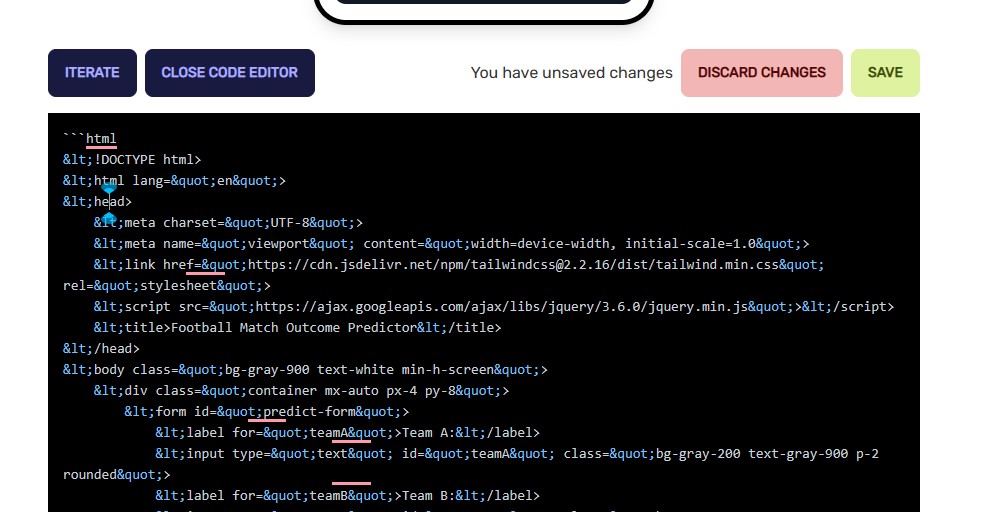 If you are a developer instead, the second method of modifying, consisting of directly editing the code, might cam in handy. To edit code, Click the “EDIT CODE DIRECTLY” option. As seen in the image above, the code is rendered in the above code editor. This permits us to quickly fix the ” ”’html ” appearing at the top of the page, by deleting it.
If you are a developer instead, the second method of modifying, consisting of directly editing the code, might cam in handy. To edit code, Click the “EDIT CODE DIRECTLY” option. As seen in the image above, the code is rendered in the above code editor. This permits us to quickly fix the ” ”’html ” appearing at the top of the page, by deleting it.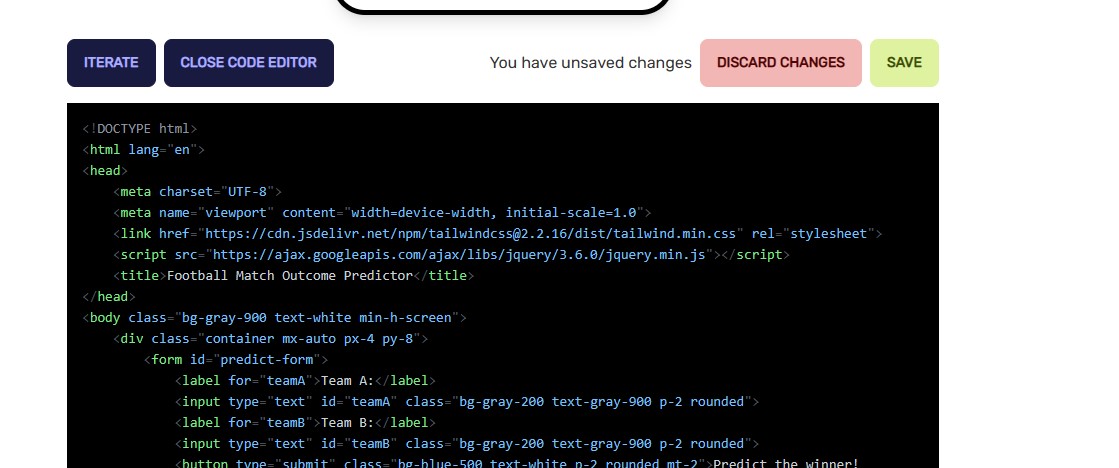 After modifying the code, verify if everything is fine and save your work. As you can see, the ” ”’html ” line has been removed.
After modifying the code, verify if everything is fine and save your work. As you can see, the ” ”’html ” line has been removed.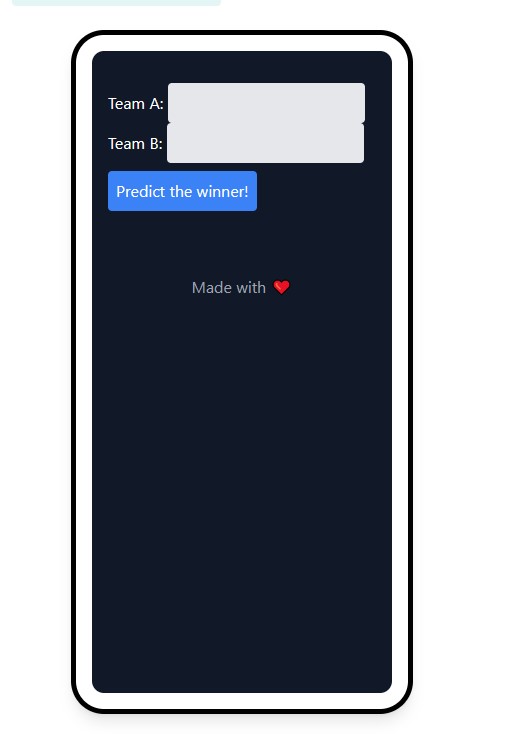 After completing your modifications, you can preview your app to make sure everything is stable.
After completing your modifications, you can preview your app to make sure everything is stable. Below the input text bar at the top, you will find a generated link to the hosted version of your project. You can use the link to access the live version of your project or share it with others.
Below the input text bar at the top, you will find a generated link to the hosted version of your project. You can use the link to access the live version of your project or share it with others.

